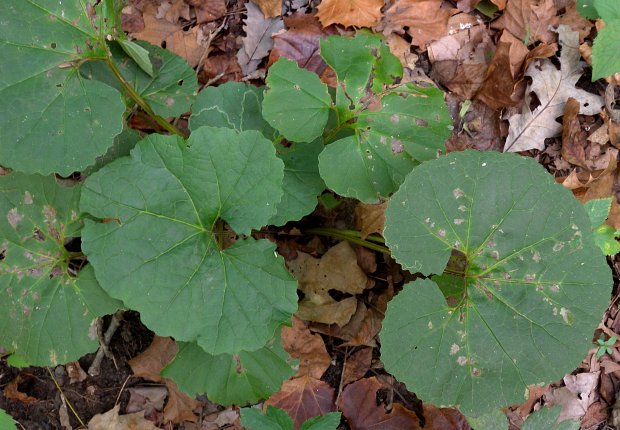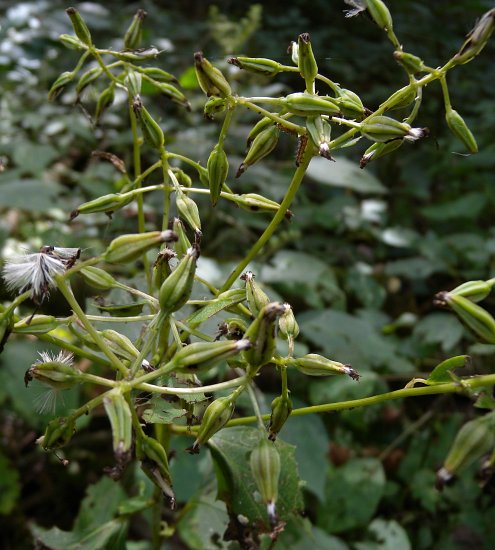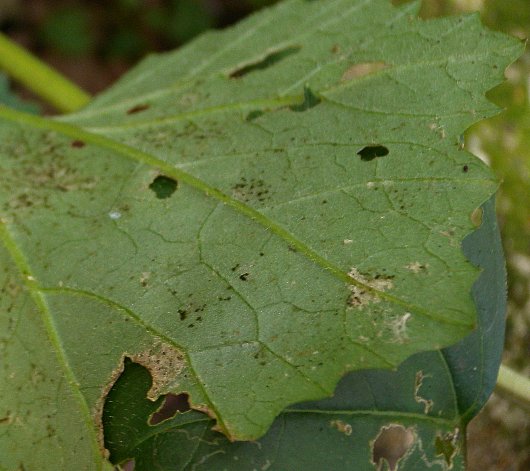Great Indian
Plantain
Arnoglossum reniforme
Aster family (Asteraceae)
Arnoglossum reniforme
Aster family (Asteraceae)
Description:
This herbaceous perennial plant forms loose tufts of large basal leaves
that are 8–24" across and 8–20" long on petioles up to 12" long; the
blades of these basal leaves are usually held parallel in relation to
the ground. The basal leaves are reniform-orbicular in shape with
margins that are coarsely crenate or crenate-dentate, slightly
undulate, and sometimes
shallowly lobed. Stems with alternate leaves are often produced that
terminate in ;inflorescences; these hairless stems are 3¼–9' tall,
light green or light yellowish green or purplish green, and terete with
rounded
longitudinal ridges and narrow furrows. The stems are normally erect or
ascending, but they sometimes topple over. Alternate leaves occur along
the entire length of each stem, becoming gradually smaller in size as
they ascend and with shorter petioles; they are up to 12" across and
10" long. The alternate leaves are mostly reniform-orbicular to
orbicular in shape, although the uppermost alternate leaves are often
oval-ovate or oval-obovate. The margins of the alternate leaves are
coarsely
crenate, coarsely dentate, slightly undulate, and sometimes shallowly
lobed. The upper surface of both the basal and alternate leaves is
grayish green to dark green and hairless, while the lower surface of
these leaves is light grayish green, sparsely short-hairy along the
veins, and either hairless to finely short-pubescent between the veins.
The bases of both the basal and alternate leaves are truncate-cordate,
except for the uppermost alternate leaves, which are often rounded or
broadly wedge-shaped (cuneate). The relatively stout petioles of both
the basal and alternate leaves are light green to light yellowish
green, sometimes with purplish upper edges; they are convex below,
deeply concave above, and hairless.

Each central stem terminates in a flat-headed panicle of flowerheads about 3–10" across. Individual flowerheads are about 8–11 mm. long, 3–5 mm. across, and lanceoloid in shape, consisting of 5 light green floral bracts (phyllaries) that are appressed together and 5 perfect disk florets with white or cream-colored corollas. Individual floral bracts are narrowly oblong-lanceolate in shape, bluntly keeled, and hairless. Individual corollas have narrowly tubular bases with 5 rather long recurved lobes. Peduncle and primary lateral branches of the panicle are light green with yellowish, whitish, or purplish tints; they are angular or terete with longitudinal furrows, and largely hairless. The lateral branches of the inflorescence are ascending-straight or ascending-incurved. The petioles are usually shorter than the flowerheads, forming somewhat divergent clusters of flowerheads within the inflorescence; they are similar to the branches of the inflorescence, except they tend to be more whitish. Sometimes there are 1 or 2 minute bractlets along the length of each pedicel. The blooming period occurs during the summer, lasting about 3 weeks for a colony of plants. The flowerheads are fragrant. Afterwards, the florets are replaced by achenes with white tufts of hair. The dark-colored achenes are about 4–5 mm. long and narrowly ellipsoid-oblongoid in shape with 5 inconspicuous narrow ridges; they are distributed by the wind. The root system has fleshy fibrous roots. This plant reproduces by reseeding itself; it sometimes forms small colonies.

Cultivation: The preference is partial sun to medium shade, moist to mesic conditions, and loamy or silty soil with decaying organic matter. After it has germinated from seed, this plant will not flower until the second or third year. It can become quite large in size.
Range & Habitat: The native Great Indian Plantain (Arnoglossum reniforme) is uncommon in southern and central Illinois, while in the northern section of the state it is rare (see Distribution Map). This herbaceous plant occurs in the central and northern Mississippi River valley, the Ohio River Valley, the Appalachian mountains, and areas in between in the United States. Habitats include bottomland woodlands, wooded areas along streams, open woodlands, wooded bluffs, lower slopes of wooded bluffs, and areas at the bottom of wooded bluffs. Great Indian Plantain is normally found in high quality wooded habitats.

Faunal Associations: The nectar and pollen of the flowerheads attract primarily bees, wasps, and flies, including little carpenter bees (Ceratina spp.), Halictid bees (Halictus spp., Lasioglossum spp.), masked bees (Hylaeus spp.), Sphecid wasps (Cerceris spp., Ammophila spp.), Eumenine wasps (Ancistrocerus spp., Parancistrocerus spp., Stenodynerus spp.), Syrphid flies (Eristalis spp., Toxomerus spp.), soldier flies (Stratiomyidae), Tachinid flies, and Muscid flies (Robertson, 1929; Graenicher, 1909). The larvae of a Gracillariid moth, Phyllocnistis insignis, are serpentine leaf-miners of Great Indian Plantain (Arnoglossum reniforme) and other Arnoglossum spp. (Indian Plantain). The stems of these plants are bored by the larvae of the Maritime Sunflower Borer Moth (Papaipema maritima) and the larvae of a lizard beetle, Languria bicolor (Natural History Museum website, 2010; Panzer, 2006; Vestal, 1913).
Photographic Location: A wooded area near a river in Fox Ridge State Park in Coles County, Illinois.

Comments: The large basal leaves of Great Indian Plantain (Arnoglossum reniforme) often persist through the summer. They are reasonably attractive. The flowerheads are less showy, but still reasonably attractive during the relatively short period when they are in bloom. Unfortunately, this plant is rarely available through nurseries, even though it could be cultivated in shaded areas if there is sufficient space for it. Great Indian Plantain can be confused with the similar Pale Indian Plantain (Arnoglossum atriplicifolium), which tends to occur in more upland areas and tolerates more sunlight. Both the basal and alternate leaves of Great Indian Plantain tend to be less lobed and less sharply toothed than those of Pale Indian Plantain, and the former plant tends to have more abundant blunt teeth along the margins of its leaves. The leaf undersides of Great Indian Plantain are not glaucous and conspicuously whitened, unlike the leaf undersides of Great Indian Plantain. There are also minor differences in the structural shapes of the flowerheads of these two plants: the floral bracts (phyllaries) of Great Indian Plantain are more lanceolate in shape and keeled, while those of Pale Indian Plantain are more oblong in shape and flat. In addition, the lobes of the corollas of Great Indian Plantain are longer than those of Pale Indian Plantain. Another scientific name of Great Indian Plantain is Cacalia muhlenbergii, which is considered obsolete.

Each central stem terminates in a flat-headed panicle of flowerheads about 3–10" across. Individual flowerheads are about 8–11 mm. long, 3–5 mm. across, and lanceoloid in shape, consisting of 5 light green floral bracts (phyllaries) that are appressed together and 5 perfect disk florets with white or cream-colored corollas. Individual floral bracts are narrowly oblong-lanceolate in shape, bluntly keeled, and hairless. Individual corollas have narrowly tubular bases with 5 rather long recurved lobes. Peduncle and primary lateral branches of the panicle are light green with yellowish, whitish, or purplish tints; they are angular or terete with longitudinal furrows, and largely hairless. The lateral branches of the inflorescence are ascending-straight or ascending-incurved. The petioles are usually shorter than the flowerheads, forming somewhat divergent clusters of flowerheads within the inflorescence; they are similar to the branches of the inflorescence, except they tend to be more whitish. Sometimes there are 1 or 2 minute bractlets along the length of each pedicel. The blooming period occurs during the summer, lasting about 3 weeks for a colony of plants. The flowerheads are fragrant. Afterwards, the florets are replaced by achenes with white tufts of hair. The dark-colored achenes are about 4–5 mm. long and narrowly ellipsoid-oblongoid in shape with 5 inconspicuous narrow ridges; they are distributed by the wind. The root system has fleshy fibrous roots. This plant reproduces by reseeding itself; it sometimes forms small colonies.

Cultivation: The preference is partial sun to medium shade, moist to mesic conditions, and loamy or silty soil with decaying organic matter. After it has germinated from seed, this plant will not flower until the second or third year. It can become quite large in size.
Range & Habitat: The native Great Indian Plantain (Arnoglossum reniforme) is uncommon in southern and central Illinois, while in the northern section of the state it is rare (see Distribution Map). This herbaceous plant occurs in the central and northern Mississippi River valley, the Ohio River Valley, the Appalachian mountains, and areas in between in the United States. Habitats include bottomland woodlands, wooded areas along streams, open woodlands, wooded bluffs, lower slopes of wooded bluffs, and areas at the bottom of wooded bluffs. Great Indian Plantain is normally found in high quality wooded habitats.

Faunal Associations: The nectar and pollen of the flowerheads attract primarily bees, wasps, and flies, including little carpenter bees (Ceratina spp.), Halictid bees (Halictus spp., Lasioglossum spp.), masked bees (Hylaeus spp.), Sphecid wasps (Cerceris spp., Ammophila spp.), Eumenine wasps (Ancistrocerus spp., Parancistrocerus spp., Stenodynerus spp.), Syrphid flies (Eristalis spp., Toxomerus spp.), soldier flies (Stratiomyidae), Tachinid flies, and Muscid flies (Robertson, 1929; Graenicher, 1909). The larvae of a Gracillariid moth, Phyllocnistis insignis, are serpentine leaf-miners of Great Indian Plantain (Arnoglossum reniforme) and other Arnoglossum spp. (Indian Plantain). The stems of these plants are bored by the larvae of the Maritime Sunflower Borer Moth (Papaipema maritima) and the larvae of a lizard beetle, Languria bicolor (Natural History Museum website, 2010; Panzer, 2006; Vestal, 1913).
Photographic Location: A wooded area near a river in Fox Ridge State Park in Coles County, Illinois.

Comments: The large basal leaves of Great Indian Plantain (Arnoglossum reniforme) often persist through the summer. They are reasonably attractive. The flowerheads are less showy, but still reasonably attractive during the relatively short period when they are in bloom. Unfortunately, this plant is rarely available through nurseries, even though it could be cultivated in shaded areas if there is sufficient space for it. Great Indian Plantain can be confused with the similar Pale Indian Plantain (Arnoglossum atriplicifolium), which tends to occur in more upland areas and tolerates more sunlight. Both the basal and alternate leaves of Great Indian Plantain tend to be less lobed and less sharply toothed than those of Pale Indian Plantain, and the former plant tends to have more abundant blunt teeth along the margins of its leaves. The leaf undersides of Great Indian Plantain are not glaucous and conspicuously whitened, unlike the leaf undersides of Great Indian Plantain. There are also minor differences in the structural shapes of the flowerheads of these two plants: the floral bracts (phyllaries) of Great Indian Plantain are more lanceolate in shape and keeled, while those of Pale Indian Plantain are more oblong in shape and flat. In addition, the lobes of the corollas of Great Indian Plantain are longer than those of Pale Indian Plantain. Another scientific name of Great Indian Plantain is Cacalia muhlenbergii, which is considered obsolete.